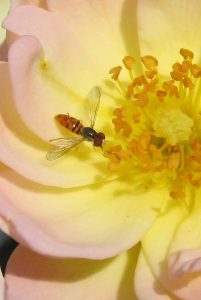$1.15 billion. That’s what the 450 species of wild pollinators that call New York home contribute to our agricultural economy each year. But we’ve seen alarming declines in pollinators of every stripe and color. Some are bees and wasps. Others are flies and butterflies (and on the night shift, moths). Their loss is worrisome to everyone from rooftop gardeners to farmers with a thousand-plus acres in crops. These people depend on pollinators to grow the foods we eat, foods ranging from pumpkins and pears to blueberries and beans.
In fact, anyone with a garden or even planter boxes on their balcony has reason to care about pollinators. And there’s no time like the present to start planning for this year’s pollinator plantings.

IPM’s mission covers everything from farms and vineyards to backyards and parks, protecting all kinds of non-target plants and animals (even covert pollinators like tiny bees and flies ). That’s why we were invited to help out in 2015 when Governor Cuomo announced an interagency task force, led by the New York State Department of Agriculture and Markets and the Department of Environmental Conservation, to develop and promote the New York State Pollinator Protection Plan, or PPP. In fact, New York is among the first 10 states to officially adopt a PPP.
The PPP was released in 2016. And the best thing is, it’s not going to stay on the shelf. This is a living document, a roadmap of sorts to guide IPM researchers and educators, farmers and householders as they plan IPPM—Integrated Pest and Pollinator Management protocols — to keep pollinators healthy for decades to come.
We’re pleased to be aboard.